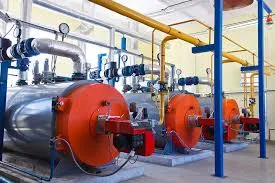
Dec . 23, 2024 14:27 Back to list
Design and Optimization of High-Pressure Steam Systems for Industrial Applications
High Pressure Steam Systems An Overview
High pressure steam systems are integral to numerous industrial processes, providing efficient thermal energy for a variety of applications. These systems operate at pressures significantly above atmospheric levels, typically exceeding 15 psi (pounds per square inch) and often reaching over 100 psi. The use of high-pressure steam is widespread in industries such as power generation, chemical manufacturing, food processing, and even residential heating. This article delves into the components, advantages, applications, and safety considerations of high-pressure steam systems.
Components of High Pressure Steam Systems
A high-pressure steam system comprises several key components that work together to produce and distribute steam effectively. The primary components include
1. Boiler The heart of the steam system, the boiler converts water into steam using heat from combustion or electrical energy. High-pressure boilers are designed to withstand the extreme conditions of high-pressure operation.
2. Steam Piping Insulated piping systems transport steam from the boiler to various points of use. These pipes must be constructed of durable materials to handle the high pressures and temperatures involved.
3. Steam Trap Essential for managing the flow of steam, steam traps allow condensate to escape while preventing steam from being lost. They ensure efficient operation and energy conservation by maintaining the system's pressure balance.
4. Heat Exchangers These devices transfer thermal energy from steam to other fluids in applications such as heating or process heating. They play a crucial role in optimizing energy efficiency.
5. Control Systems Automated control systems monitor and manage pressure, temperature, and flow rates within the steam system, ensuring safe and efficient operation.
Advantages of High Pressure Steam Systems
High-pressure steam systems offer several significant advantages that make them preferred in industrial settings
- Increased Efficiency Operating at higher pressures raises the boiling point of water, which allows for better heat transfer efficiency
. This capability enables processes to complete more quickly and with less energy consumption.high pressure steam system

- Reduced Water Consumption Because high-pressure systems generate steam more efficiently, they typically require less water than low-pressure alternatives. This reduction is crucial in water-scarce regions or industries where water costs are a significant concern.
- Versatility High-pressure steam can be used for a variety of applications, including heating, sterilization, and power generation. This versatility means that a single steam system can service multiple operational needs.
- Enhanced Heating Capacity High-pressure steam delivers more thermal energy in a shorter time, making it ideal for industries that require rapid heating, such as food processing and chemical manufacturing.
Applications of High Pressure Steam Systems
High-pressure steam systems find their applications in various sectors, including
- Power Generation Many power plants utilize high-pressure steam to drive turbines, converting thermal energy into electrical energy.
- Chemical Processing In the chemical industry, high-pressure steam is used for reactions, distillations, and drying processes.
- Food Processing High-pressure steam plays a crucial role in cooking, pasteurization, and sterilization of food products.
- Oil and Gas Industry High-pressure steam is employed in enhanced oil recovery processes and in the refining of crude oil.
Safety Considerations
While high-pressure steam systems offer numerous benefits, they also come with safety risks that must be managed diligently. Leaks or failures in the system can lead to catastrophic steam explosions, severe burns, or equipment damage. It is essential for operators to implement robust safety measures, including regular maintenance, pressure relief valves, and comprehensive training for personnel.
In conclusion, high-pressure steam systems are vital for enhancing efficiency and versatility in numerous industrial applications. Their ability to provide substantial thermal energy while minimizing resource consumption makes them indispensable in contemporary manufacturing and processing environments. As industries continue to seek more efficient ways to produce and use energy, the importance of high-pressure steam systems is expected to grow, underscoring the need for safety and innovation in their operation.
-
High-Efficiency Commercial Oil Fired Steam Boiler for Industry
NewsJul.30,2025
-
High-Efficiency Biomass Fired Thermal Oil Boiler Solutions
NewsJul.30,2025
-
High Efficiency Gas Fired Thermal Oil Boiler for Industrial Heating
NewsJul.29,2025
-
High-Efficiency Gas Fired Hot Water Boiler for Sale – Reliable & Affordable
NewsJul.29,2025
-
High Efficiency Biomass Fired Hot Water Boiler for Industrial and Commercial Use
NewsJul.29,2025
-
High-Efficiency Biomass Fired Hot Water Boiler for Industrial Use
NewsJul.28,2025
Related PRODUCTS






















